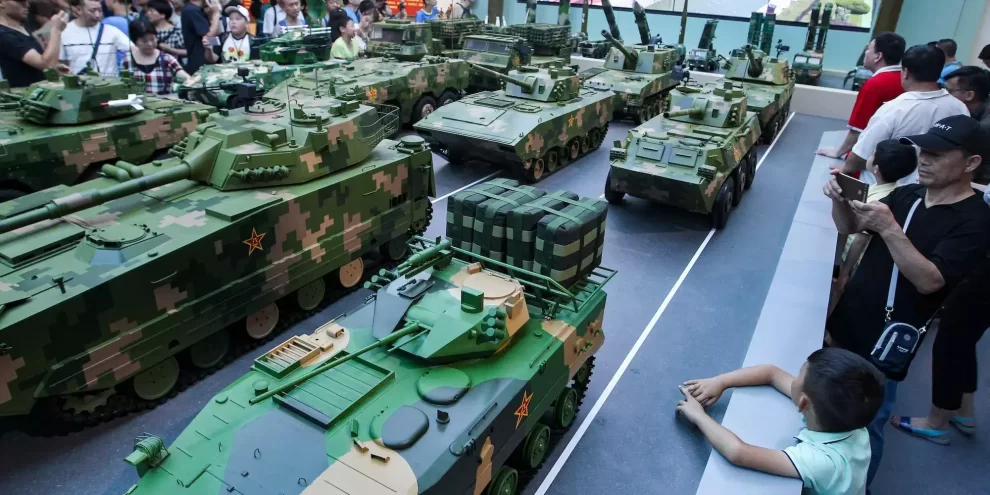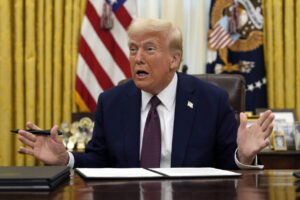For countries interested in Chinese weapons, it is buyer beware, warns a US think tank. Chinese arms may be cheaper than those of competitors, but they can prove more costly in the long run.
“China attracts customers for its military equipment with cut-rate pricing and financing, but there are hidden costs — especially when gear malfunctions,” Cindy Zheng, a researcher at the RAND Corporation think tank, wrote in a recent blog post.
Despite the drawbacks, Chinese arms exports may get a boost from the war in Ukraine. Russia’s focus on producing weapons to replenish its own military rather than for export is likely to create market opportunities for Beijing to use arms sales to gain profit and spread its influence.
For developing nations with limited defense budgets, Chinese arms are tempting. China can offer an array of military equipment, from missiles and warships to armored vehicles and drones. Even China’s high-end arms are relatively cheap.
A JF-17 fighter — a joint Chinese-Pakistani design roughly comparable to an F-16 — costs $15 million to $25 million, by some estimates. A Block 70 F-16, the latest version, costs about $65 million.
Yet much like buying a used car, the sticker price may not reflect the true cost of ownership, especially for the less developed nations — mostly in Africa, the Middle East, and South Asia — that buy the bulk of Chinese weapons.
“A lack of technological compatibility with the Chinese military equipment can prove particularly expensive,” Zheng wrote. “Countries often do not have the personnel with the expertise and training to resolve issues. They also can have difficulty acquiring replacement parts.”
For example, Nigeria sent many of its F-7 fighters — a Chinese version of the 1960s-era Soviet MiG-21 — back to China in 2020 for intensive maintenance because the Nigerian Air Force lacked the equipment to do it.
Myanmar had to ground most of its JF-17 fighters in 2022 over technical issues. In addition to a fragile airframe during high-G maneuvers, the JF-17’s radar reportedly has poor accuracy and reliability. “The aircraft does not even have an effective beyond-visual-range (BVR) missile or airborne interception radar,” according to The Irrawaddy, a news site covering events in Myanmar.
Bangladesh has experienced problems with its Chinese-made K-8W jet trainers and HQ-7 air-defense systems. Most significant, Pakistan — the biggest importer of Chinese arms — has had issues with its Chinese-made F-22P frigates, including sensor and engine defects, forcing Pakistan’s navy to operate the ships in a less than fully capable status.
Quality concerns could be one reason for a pre-Ukraine decline in Chinese arms sales. A recent survey by the Stockholm International Peace Research Institute, which tracks global arms sales, found a 23% decrease in Chinese arms exports between the 2013-2017 and 2018-2022 periods.
On the other hand, SIPRI also found that German and British arms sales declined 35% and Israeli sales fell 15% during the same period. Nor are defective weapons exclusively a Chinese problem: The US’s F-35 stealth fighter and Germany’s Puma infantry fighting vehicle have been plagued with technical issues.
China could be cutting back on exports to stockpile weapons for itself. “In the face of increased geopolitical tensions, China may be shifting attention back to meet its national and domestic goals,” Zheng told Insider. “Lower customer financial priorities during COVID for Chinese-made weaponry could also be a factor.”
Either way, the appeal of Chinese weapons has never been their technical capabilities. China offers easy credit and serves an alternative for nations that prefer not to depend on a single weapons supplier. Equally important is that Beijing has few scruples about arms sales and doesn’t tie them to human-rights issues.
“China also isn’t particularly discerning in who it will or won’t sell to,” Zheng wrote. “Its arms deals have few political contingencies involved. In Africa, sales appear driven by profit and trying to grab market share from Russia.”
Arms exports are often meant to serve interests beyond profit. Small but technologically advanced nations use them to subsidize their own defense industrial bases and make their weapons more affordable. Others use them to strengthen relationships and meet needs at home — Venezuela has become Latin America’s top buyer of Chinese weapons and Iran has maintained security ties with Beijing. In return, China gets cheap oil from both countries.
A downside is loading up on loans to buy military hardware can leave poorer countries in a debt trap, a dynamic that has drawn international backlash against China.
The arms export competition with Russia will be particularly interesting. China has cautiously supported Russia’s invasion of Ukraine. Yet some US experts think China will displace Russia as king of the “value arms” market.
Whether China will succeed in selling more complex weapons, such as jet fighters, remains to be seen. “It is too soon to determine the quality of Chinese-made advanced weapons due to the lack of client reviews and because its advanced weaponry is still comparatively low in ratio to its current exports in the lower-value arms market,” Zheng told Insider.
Nor does China want to diminish Russia — for now, at least. “China understands that Russian arms exports still play an important role in the international stage, especially for Russia’s influence in the world,” Zheng said. “As Russia’s weapons availability may change as the war continues, China is prepared for when that time arrives.”
Source : Insider










